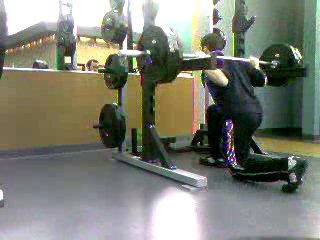Why muscular strength is the MOST important component of fitness and how to train for it!

Muscular strength is the maximum amount of force that can be produced by a muscle/muscle-group, often measured via 1-rep-max (1RM). Furthermore, strength has the most functional carryover to other components of fitness; which makes knowing how to train for it of high importance.
Interrelationships of strength and overall fitness
Among the merits of strength is that it's enhancement improves overall fitness; whereas training other components of fitness tend to benefit strength far less.
There are 5 universally recognized components of fitness. Those components are cardiovascular endurance, flexibility, body-composition, muscular endurance, and strength. Strength training enhances performance association with all fitness components while the reciprocal is less true.
Cardiovascular endurance
Cardiovascular endurance is enhanced by increased strength in that it increases load capacity of the muscles powered by the cardiovascular system. In other words, increased strength doesn't necessarily allow you to run longer unloaded, but allows you to carry a heavier backpack on your run.
In the other direction, however, cardiovascular training actually can compromise strength. Cardiovascular exercise trains the neuromuscular system to ration force to get more miles per calorie. This results in the nerves connecting to fewer muscle fibers and using energy slower; which is like a car running on fewer cylinders resulting in less torque. So cardio just benefits cardio.
Flexibility
On the flexibility front, increased strength at any joint angle allows for greater ability to venture to and beyond said angle. Flexibility training alone, however, results in joints venturing into positions of weakness making the body more vulnerable to injury.
Muscular endurance
Functional muscular endurance is the ability to repeat/maintain sufficient muscular force for a functional duration (minutes not hours! ). Note, however, that, for muscular endurance to be functional, it must be of a sufficient force level. For example, having infinite endurance lifting/suspending a feather is of little value; whereas the ability to military press 200lbs just once can be of immense value for lifting/holding a heavy sheet of drywall above the head.
As such, muscular endurance is complimented by strength the same way cardio endurance is. Increased strength allows for a higher level of repeatable/sustainable of force. Muscular endurance training, however, can elicit neuromuscular adaptations less conducive to force.
Body composition
Training for increased muscular strength helps maintain/increase muscle-mass which supports good body composition. Efforts to improve body composition outside strength training (hypo-caloric diets, aerobics etc) deplete strength and muscle mass.
Training for muscular strength
As far as muscular strength training is concerned, few gym-rats understand how to do it. What you commonly see is people either repping complaisantly and/or forcing reps well beyond fatigue. What you rarely see is focused effort to challenge muscles to produce maximum force; which entails forceful reps and minimum fatigue.
And, despite the fact that high volume/fatigue methods can increase strength very intermittently, such methods often incline adaptations that reduce muscular force. To gain strength at any experience level, training must challenge the muscles in a way that can only be met by adaptations conducive to strength.
How exercise challenges the body
Exercise challenges the body in many ways. Among those ways can be energetic and/or structural. Energetic challenges place demands on fuel storage and expenditure rate. Structural challenges place demands on the integrity/function of tissues (muscles, bones, ligaments, nerves etc).
Challenges to muscular strength include increased energy-expenditure-rate and greater structural capacity for tension/force. Increased energy-expenditure rate is met energetically via increased fast-energy-reserves as well as the ability to break it down. Structurally, increased expenditure rate is met by increased nerve innervation of muscles. Greater tension-capacity is met structurally via stronger tissues (muscles, bones, ligaments etc).
Counter to muscular strength are challenges to prolong work. Like changes to improve gas mileage the body responds via downsized expenditure rate and tension production. Energetically, adaptations to less-force/more-fatigue include increased storage of slow-energy with decreases in fast-energy capacity. Structurally, less-force/more-fatigue adaptations include neural/muscuoloskeletal changes that result in less force/torque.
How and how not to challenge strength
To demand greater expenditure rate and force capacity of muscles, contract muscles as fast and forcefully as possible. Lifting sufficiently heavy as fast as possible is the way to do this. For muscles to lift heavy weight faster, energy has to be expended faster and/or the involved structures have to become more capable of transmitting/tolerating force.
Challenging muscles to lift/suspend weights longer. runs the risk or eliciting strength-sapping adaptations. While prolonging sets can cause protein-damage-induced growth, adaptations that lessen rep-force can result. Adaptations like less nerve innervation and less fast-energy chemistry. Such changes are similar to those made to a car to increase gas-mileage (less torque, slower fuel delivery etc).
Moving forward
So next time you're contemplating how to spend your limited training time, consider the vast benefits of muscular strength. Furthermore make sure your training is truly challenging muscular strength!